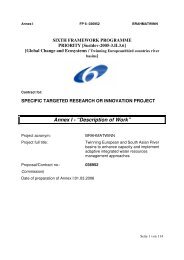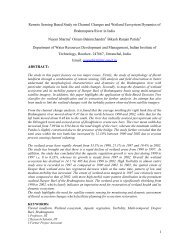WP 5 Analysis of present IWRM practices - Brahmatwinn
WP 5 Analysis of present IWRM practices - Brahmatwinn
WP 5 Analysis of present IWRM practices - Brahmatwinn
You also want an ePaper? Increase the reach of your titles
YUMPU automatically turns print PDFs into web optimized ePapers that Google loves.
• A complex, and sometimes conflicting, legal framework exists within the UDRB at the<br />
regional level (EU and UN ECE), at the basin level (1994 Danube Convention), and at the<br />
national level (national water legislation); whereas in the UBRB regional, basin and national<br />
frameworks remain weak.<br />
• Moreover, the implementation <strong>of</strong> the WFD has resulted in the formulization <strong>of</strong> <strong>IWRM</strong><br />
<strong>practices</strong> at the UDRB scale, while a similar legislation does not exist in the UBRB.<br />
• Trans-boundary conflicts in the UDRB are on the whole resolved through the regional and<br />
basin-wide legal framework, but in the geo-political sensitive UBRB there is still a long way to<br />
go before a similar situation can be recognized.<br />
• Socio-economic development is based on agriculture, industry, forestry, hydropower<br />
generation and tourism in the UDRB and mainly on agriculture, forestry, hydropower<br />
generation, and mining in the UBRB, and in the latter per capita income is very low if<br />
compared to the UDRB.<br />
• In relation to <strong>IWRM</strong> gender issues are <strong>of</strong> no importance in the UDRB but have to be<br />
considered in different degree in the UBRB.<br />
• Impacts <strong>of</strong> climate change to the natural environment common for both basins are likely to<br />
differ regarding the human dimension and socio-economic environment in the UDRB and<br />
UBRB.<br />
Water availability is influenced by natural and human influences. A summary <strong>of</strong> water related issues,<br />
e.g. water availability, water demand, climate conditions, population and land use in both basins and<br />
test sites is <strong>present</strong>ed in the following chapters. Additionally water management and administration<br />
is described, which includes an illustration <strong>of</strong> responsible institutions and organizations as well as<br />
strategies and plans in respect to water resources management.<br />
The Integrated Water Resources Management (<strong>IWRM</strong>) is an international accepted approach. <strong>IWRM</strong><br />
is a balancing multi-sectoral process to make decisions for water resources management and related<br />
issues. <strong>IWRM</strong> is a flexible tool to manage the water resources sustainable to ensure water availability<br />
and to shelter the ecological function <strong>of</strong> water bodies. The main topic <strong>of</strong> <strong>IWRM</strong> is to manage the<br />
water resources in a way first to secure water availability in sufficient quantity and quality for the<br />
population and secondly to avoid hazards like floods and droughts. <strong>IWRM</strong> is characterized by a<br />
sustainable management <strong>of</strong> the resource water and has to consider all three pillars <strong>of</strong> a sustainable<br />
development which are the natural and the social environment as well as the economic dimension.<br />
The river basins are dominated by both human impacts and mountain related processes. The main<br />
threats are posed by unsustainable agricultural <strong>practices</strong> (strong imports <strong>of</strong> cattle feed and use <strong>of</strong><br />
pesticide, overgrazing, erosion) and growth <strong>of</strong> settlements, that cause significant degradation <strong>of</strong><br />
natural resources (groundwater, plants, soils).<br />
Climate change is expected to destabilize and alter the biological system mainly within the mountain<br />
regions. Tourism as one drive towards sustainable land use will be strongly and negatively affected.<br />
In fact, the fourth assessment report by the IPCC does support this claim, Climate change is also<br />
expected to have large impacts on catchment hydrology. Additionally the loss <strong>of</strong> glaciated areas is<br />
threatening both ecosystems and human activities. Climate change is also causing degradation <strong>of</strong><br />
mountain forests and increasing avalanche danger.<br />
At the policy level, both river basins are trans-boundary basins. They require a management<br />
approach under involvement <strong>of</strong> all riparian states. The Upper Danube delivers a large portion<br />
4





